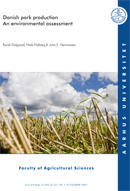An environmental assessment of pork production

Feed production and slurry handling are the most polluting links in the Danish pork production chain, whereas pig transport pollutes only slightly.
Such are the results of a report by the Faculty of Agricultural Sciences, University of Aarhus in Denmark.
Using the Life Cycle Assessment (LCA) methodology, the study aims to present data for the environmental profile of pork to identify the most polluting parts of the production chain. It is based on data from 2005.
Findings
The greatest contributions to global warming, eutrophication and acidification are from feed production and from manure handling in pig housing and during storage according to the report. Slurry applied to the fields also contributes significantly to eutrophication.
Reduced environmental effect
The scientists found that the environmental effect per kg pork has fallen since 1995.
Environmental improvements have primarily been achieved because of lower feed and protein consumption and improved manure handling. However, there is still room for improvement.
In particular, greenhouse gas emission per kg pork can be reduced by using the slurry for biogas and using the biogas for production of electricity and heat.
The publication “Danish Pork Production – An Environmental Assessment” is available here.











